We talk a lot about the value of email marketing. After all, email marketing is the king of the marketing kingdom, with a 3800% ROI and $38 for every $1 spent. Email can help lead prospects down your sales funnel and encourage existing customers to spend more time with your brand.
However, email marketing isn’t the only way marketers are getting traction in the digital space. Content marketing, Pay-Per-Click (PPC) ads, and social media are all helping marketers achieve their goals.
In fact, during a recent study, we asked small businesses where they felt their biggest opportunity to build brand awareness was, and the top two places were social media, followed by email marketing.
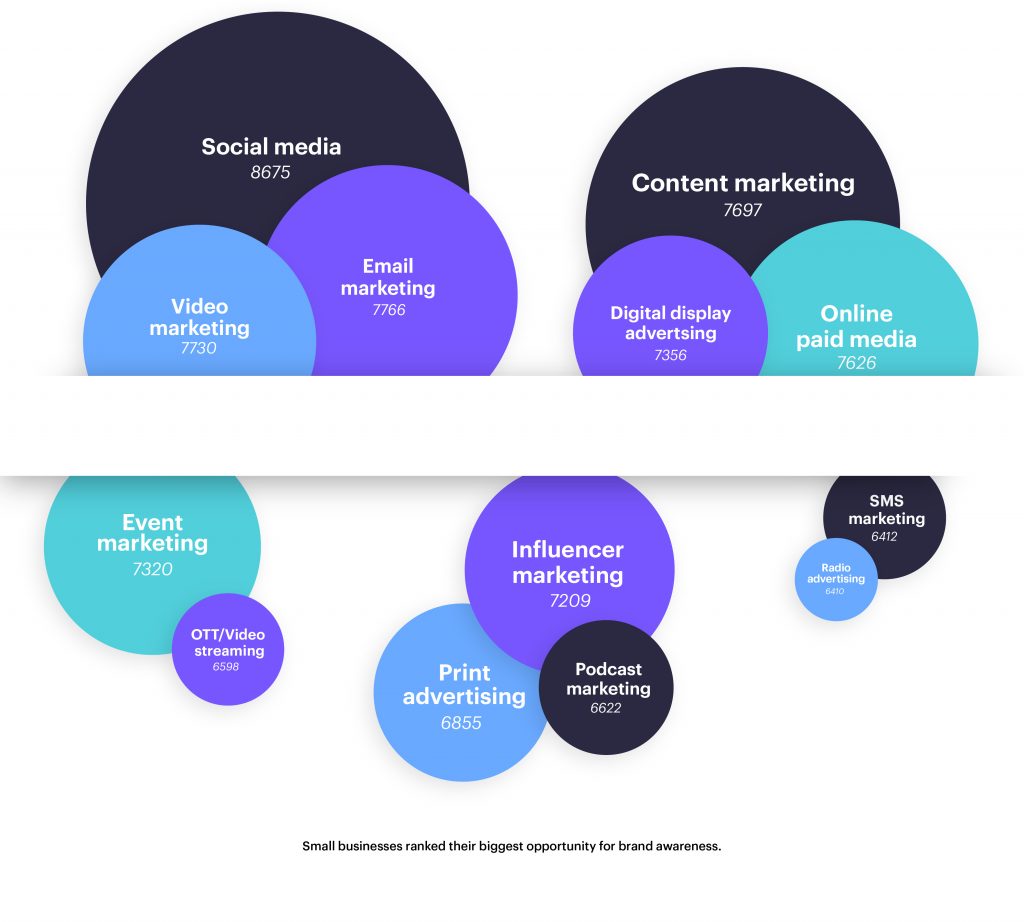
There’s more power when these tactics are used together, so, in this post, we’ll explore how you can integrate your email marketing efforts with a social media strategy. The two can complement each other to take your marketing to the next level.
Why the most successful brands have a holistic view
The most successful brands are able to integrate all branches of their marketing together to create an amazing customer experience. These brands have a holistic view of digital marketing and believe that email and social media work best when they’re used together.
When a company has a holistic approach, the connections are seamless. Whether a customer corresponds with the brand on Twitter, gets help troubleshooting through customer support, or walks into a brick-and-mortar store, the customer feels that they’re getting a consistent experience.
However, many brands don’t provide this experience, and it can negatively impact marketing efforts. When marketing teams are siloed, communication breaks down, and it’s hard to integrate new initiatives.
It becomes more difficult to run and promote campaigns, and team members become frustrated because they feel they’re limited in what they can do.
Why does email marketing still work?
If social media is higher up on marketer’s lists for gaining new prospect, then why is it that email marketing is still so heavily suggested?
To put it simply—because email marketing still works.
Seventy-two percent of consumers still prefer to receive promotional content in their email inbox versus 17% who prefer seeing it on social media. When it comes to making a purchase, 4.24% of individuals who visit a site from a link in an email promotion are likely to buy something, as compared to only 2.49% who click a link from a social media site.
How is email used in digital marketing?
Email is only one of many channels that can be utilized in a marketing team’s digital marketing strategy. As with any other channel, email requires a strategy of its own that follows a pattern similar to the following:
- Identify your target audience.
- Know what your audience’s pain points are.
- Address their needs, not yours.
- Follow up on comments/questions/concerns.
What makes email different than the rest of your digital marketing strategy? It’s just a different channel used to reach your audience.
What are the benefits of email marketing?
The benefits of email marketing are simple, and you have the most potential to reach customers that genuinely want to hear from you.
Marketing materials should only be sent to prospects once they’ve opted in to become a subscriber, so you’ll only be sending to people who genuinely want to see your content in their inboxes.
Integrating your social media marketing with your email marketing strategy
If your brand is struggling to provide a seamless digital experience, you should consider integrating your email marketing and social media efforts.
Campaign Monitor has made it simple for brands to incorporate social media into their email strategy. It’s as simple as drag, drop, and customize.
Assess where you stand with your team.
Before you can start sending your social media following requests to sign up for your email newsletter, you have to assess where you stand right now.
If you have a separate social media team, start by meeting with them. When you do, ask the following questions:
- How are we already integrating email marketing and social media?
- What social media goals can I help you reach using email?
- Do you have any ideas for how we can use social to reach our email marketing goals?
- What resonates on social media that doesn’t seem to do as well in email?
- What resonates in email that doesn’t seem to do as well on social?
Having answers to these questions can help the two teams work together to develop a plan for moving forward.
Get calendars in sync.
You might already have an email marketing calendar, but does it effectively loop in your social media team? Is your social media team using a calendar that you don’t have access to?
Sometimes, teams wind up doing the same work twice simply because they’re not aware of what the other team is doing. For example, your social media team might have a comprehensive holiday calendar that could help your email efforts. Alternatively, you might have a holiday calendar that your social media team could leverage.
Integrated calendars can help ensure that everyone is on the same page and has an idea of when campaigns begin and end. Calendars can make it easier to work together to promote initiatives and can help you schedule without conflict.
Using a calendar tool can make coordination easier. Here are a few favorite options for marketing calendars:
- Project management tools such as Trello and Asana
- Editorial calendars like CoSchedule, Percolate, and Kapost
- Google Sheets or Google Calendar
- Microsoft Excel or Microsoft Outlook
Show off social profiles in your emails.
Once the email marketing and social media teams are on the same page, you can begin to figure out ways to further support each other.
Email marketing can help increase engagement on social media by reminding subscribers that your brand has an active social community.
Fruit of the Loom encourages subscribers to engage with their brand in a fun and interactive way through this email:
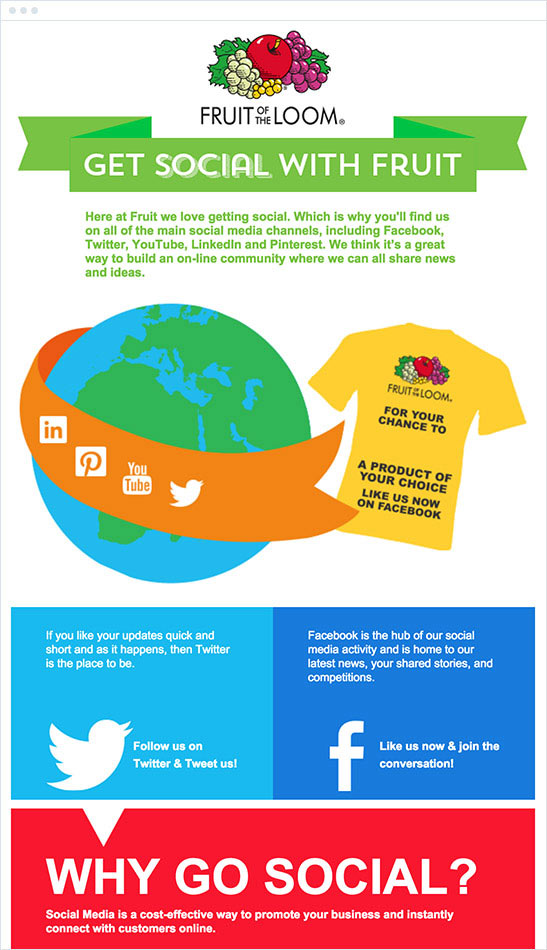
Fruit of the Loom explains the benefit of social media to their brand and what you’ll get from the two main channels they use. They also have a contest to win a product of your choice when you follow the brand on Facebook.
This strategy not only helps increase engagement on social media, but it also gives subscriber’s value, and can help keep them even more connected to your brand. By focusing on the promotion of one social network—rather than three or four—it makes it easy for subscribers to make a decision about what action to take, such as following your brand on Facebook for updates.
Encourage people to sign up for your email lists via social.
You can promote your brand’s social media profiles in your emails, but you can also encourage social media followers to sign up for your mailing lists.
One of the best ways to do this is through the use of Twitter Cards, which allow subscribers to sign up for an email list without ever leaving the social media platform.
Here, Moz encourages Twitter followers to sign up for the Moz Top 10, a bi-weekly email of curated articles.
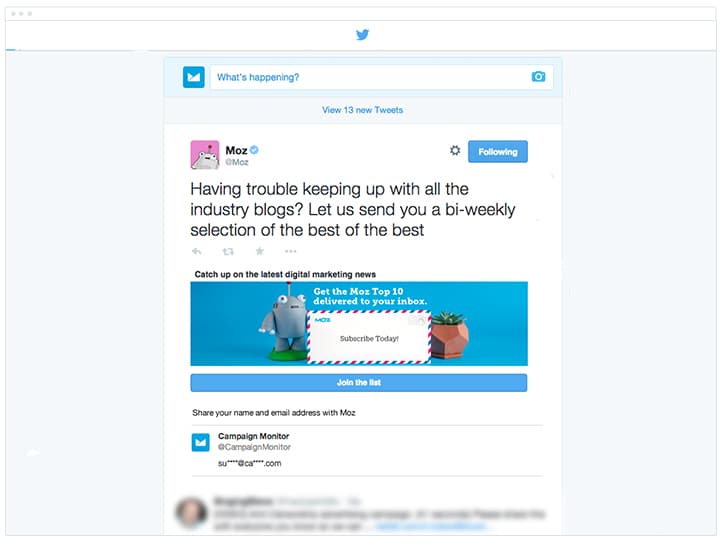
The Barista Bar uses the same strategy to encourage followers to sign up for their Coffee Club, which requires an email address.
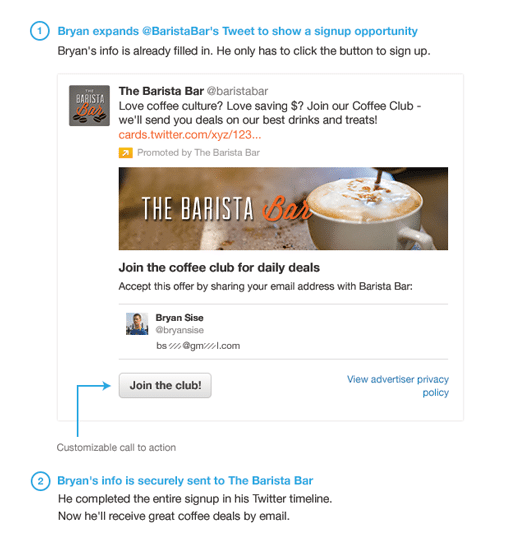
Just as you use Twitter Cards to promote your email initiatives, you can use your Facebook page to promote joining your email list, as well.
To do so, add a subscribe form to your Facebook Page. (It’s a simple setup process—just follow these instructions.) SXSW uses this strategy on their Facebook page to encourage their social fans to subscribe to their mailing list.
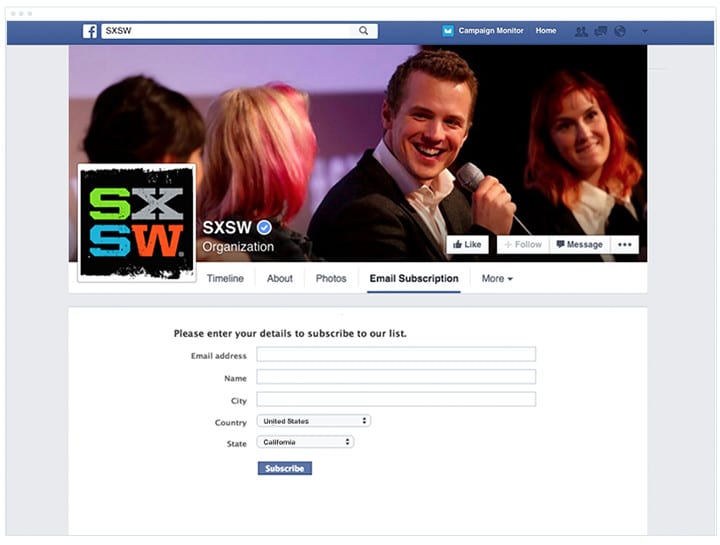
You can also remind social media followers of the cool stuff that happens on your email list, encouraging them to join. For example, Birchbox teases the benefits of signing up for their email list in many of their Facebook posts. Here, they share that people on the email list get exclusive offers.
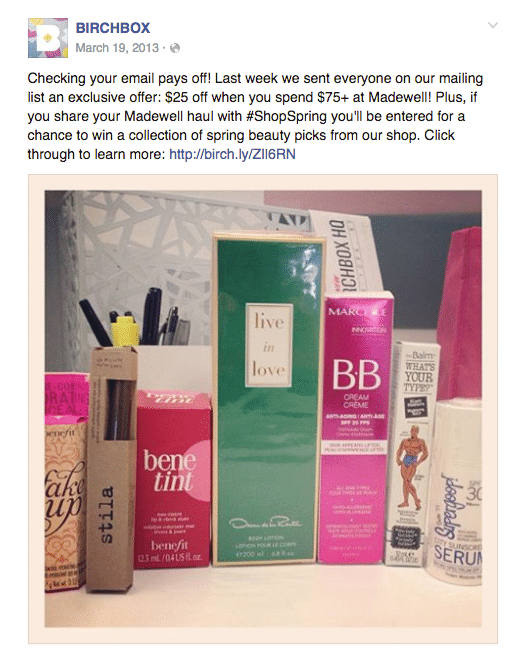
Upload your subscriber lists to social networks.
One of the absolute best ways to integrate your email and social media marketing strategies is to upload your subscriber lists to Facebook, LinkedIn, Twitter, and other social media networks.
You can use these uploaded subscriber lists to follow subscribers on social media, run promoted social media campaigns to those who are already interested in your brand, or simply create a customer list.
Facebook’s Custom Audience Feature is particularly good for this, and is used as a tool to increase your success using paid reach.
Uploading your subscriber lists will help put a name and face to your email subscribers. It’ll also help you listen to them. What’re they gabbing about? What’s interesting to them? What’re they sharing? Knowing more about your subscribers can help you craft better emails as well as better social media posts.
Retarget ads on Facebook and Twitter to interested email subscribers.
Ads are expensive, so you want to be deliberate about where you spend your funds. Retargeting those who are already interested in what you have to offer leads to better conversion rates and eliminates the chances of sending out irrelevant ads.
To set up a retargeting campaign to hit interested email subscribers, you’ll install a tracking code on your website. If you send an email to subscribers that leads to your site, you can then target ads to only the people who clicked to that page.
To set up a retargeting campaign to hit interested email subscribers, you’ll install a tracking code on your website. If you send an email to subscribers that leads to your site, you can then target ads to only the people who clicked to that page.
You can build this specific segment of your audience even faster by using Rebrandly URL Shortener. This tool adds your retargeting pixels to the links you share on social media.
With URL shorteners, you can retarget people who are interested in your social media content but have yet to visit your website.
Create a community through custom hashtags.
Social media nowadays seems to be all about the hashtag. If you use the right one on Instagram or Twitter, your post can go instantly viral. Heck, even Facebook and LinkedIn are catching on and integrating the use of hashtags on their platforms as well.
While using popular and trending hashtags is a great way to join a community of like-minded individuals, brands would be wise to try and coin their own hashtags to set their community apart from the masses.
Take country star Carrie Underwood, for example. She has a wildly popular fitness clothing brand by the name Calia by Carrie. Instead of using generic fitness hashtags, they have a unique one that they use to stand out amongst the masses: #StaythePath

Source: Instagram
User-generated content brings your brand to life.
The ultimate way to bring your social media marketing and email marketing strategies together is with user-generated content.
People have certain brands that they flock to, for whatever reason, but, when it comes to gaining new prospects, having user-generated content on both your social media and in your email marketing messaging is the way to go.
As great as celebrity endorsements can be, most people would rather choose a product based on the reviews and testimonials left by their fellow consumers.
While social media is a great way to get these customer reviews and testimonials, you can easily share them with your subscriber’s list to help you promote your brand’s products without sounding too “salesy.”
Wrap up
Marketers are finding more and more ways to integrate email marketing with other efforts. There are many ways to connect email and social media, including:
- User-generated content
- Creating brand-unique hashtags
- Sharing your social profiles via email, while promoting your subscriber list on your social pages
If trying to marry these two popular strategies together seems a little overwhelming, then we suggest you take a step back and work on building one strategy at a time. Focus in on your email marketing strategy and learn why it should be the cornerstone of your digital marketing strategy.
This post was originally published in May 2016





